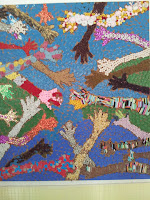1) April 1
Today I learn to look
at numbers in different ways, and see math as a natural and valuable part of
everyday activities.
- Countable
are discrete quantifiers that do not have factional parts.
They have plural form: 1book, 2 books, 3 books.
- Uncountable
are continuous quantifiers that always exist as factional parts,
such as money, water- instead we say; 1 dollar, 2 dollars or 2 cups of water
- Learn
to look out for similarity, difference or patterns. I was constantly challenged
to look for more than one way to solve a problem.
- The
everyday life of learners offers an endless array, such as how many biscuits to
make for the party or how many color pencils are needed to fill this box are
real challenges – to learn math naturally.
‘Subitise’ – a
mathematical term: the ability to tell
the number of objects in a group without counting them.
I enjoy the
lesson today. What learners need most is an adult, like Dr Yeap who fosters
their interest in math, who encourages them to test their ideas and to keep
sharing their reasoning in a supportive, non-judgmental environment. Learners
will develop positive attitudes toward and an aptitude for mathematical
learning.
Sometimes, teacher too vigor to teach children
mathematics, she can be moving quickly that when a child is able to write and
recognize numerals she think the child is ready to accelerate the topic. The child might be far from developmentally ready to acquire those kinds of math skills. Instead, the child
might need more concrete experiences with grouping of numbers
There are two
differentiated models:
Acceleration Model – go ahead of
topics different content.
Enrichment Model– staying with what
the content but offer children with more challenging tasks to help develop the
math process skills to understand the mathematical relationships around them.


